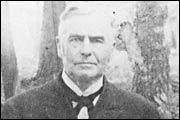|
Quillen Shinn
CHURCH IS A PLACE WHERE WE LEARN TOGETHER.
|
|
UNITARIAN UNIVERSALIST ALPHABET
Please read
the Overview before using this Plan.
Q q Letter Q introduces Quillen
Shinn, Universalist minister who started churches along the Eastern
Seacoast, and Unitarian Universalist camps and conferences.
MATERIALS:
Construction paper Letter with hole punched in top, yarn for
necklace
If you
plan to make a quilt, this will take planning and gathering of
sheeting, additional adults, and fabric markers. If it is to be a
social action project, additional parts of the church community may
be needed.
Visitor to talk about how
the church was started.
Snacks—quince
GETTING
STARTED:
Welcome.
After each person says his or her name, the group responds, “Welcome,
(name).” For a child who is attending for the first time this
year, add name to the letters that have been posted and to the
attendance sheet, and make a nametag during or after the session.
Leave an empty chair for someone who is not present or for someone
who has not joined the group yet.
The Letter
of the Day:
Talk
about the Letter.
Give
the Letter Necklace to a person with that initial.
Talk
about the things that the children have brought for the Letter, and
or Letter Bag.
Put
the things related to the letter in the Special Place
SPECIAL PERSON: Quillen
Shinn (1845-1907)
A
little over a hundred years ago, on a summer evening, Quillen Shinn
and his son took a walk after dinner. They had heard of land about
two miles from where they were staying in Ocean Park, Maine, that
sounded like a good place for Universalists to meet during the
summer. He had been leading the Universalists in summer meetings
since 1882, starting at a Methodist camp at The Weirs in New
Hampshire. Now he had been talking with the Free Will Baptists in
Ocean Park about using some of their space, but they really wanted a
place of their own where they could talk about what they believed,
and where they could have fun in the summer sun and water.
That
summer evening Quillen found the land that he was looking for! In
1901, Ferry Beach became the Universalist summer meeting place.
People reached Ferry Beach by train. Some people stayed in tents and
some stayed in the Ferry Beach House, which is now called "The
Quillen." There were lectures and discussions, workshops and
games, and beach time with friends, old and new.
Quillen
Hamilton Shinn was an Universalist minister in several churches in
Vermont, Massachusetts, and Maine. In 1891 he became a missionary
traveler, actually elected by the Universalist General Convention in
1895 to be the General Missionary for the denomination. He traveled
to many places, usually by riding a horse. He started about 50
churches and Sunday Schools, and also organized the National Young
People's Christian Union for the Universalists. He was excited about
the message that "God is Love." He also encouraged the
churches to be actively involved in social concerns in their local
areas.
AFFIRMATION: Church is
the place where we learn together.
When was your church
started? Is there any date in the church, like a corner stone?
Possibly invite someone who is familiar with the history to talk with
the group.
Questions. One of
the most important ways that we learn is by asking questions.
Sometimes we do not have the answers, but keep talking together as we
try to find the answers. We may have different answers, and we learn
from each other.
THE LETTER Q
IN THE CHURCH
Quiet. (Noise is
under Nightingale.) Sit quietly and listen to everything without
moving or making any noise for a brief time. What was it like to be
quiet? What did you hear when you were very quiet? Taking time to be
quiet can be part of the group practice as a part of each session or
when things get confusing. The length of quiet time will depend on
the group.
When are people quiet in
church (such as for meditation)?
Quilt/quilting: Talk
about quilts as a way of telling stories or making special designs.
This project will take more than a session and will require
additional adult assistance. Suggestions:
Children make their
own pictures on squares of white sheeting, or develop designs with
the help of older children or adults. These pictures are sewn
together against a backing. Draw directly onto the sheet with fabric
crayons or on paper that is later transferred to the sheeting with
an iron. The drawings can be at the decision of the child or to
follow a theme. This type of quilt will probably be used for a
hanging or room decoration. Suggestion: sign and date the
squares/quilt. The method of quilting can be used on banners and
hangings of all sizes. Important components of this activity are
working together and being creative.
Have children pick
out material to make squares for a pattern. These will need to be
sewn against a backing. An added importance for the group would be
creating a quilt for a special person or project (from AIDS quilts
to the Ronald McDonald Houses). This would be an opportunity for
social action.
Note: Fabric shops
frequently have small pieces (sometimes called scraps or end pieces)
that can be used for quilts.
A-B-C
Animals: Quail
Body:
Calendar:
Note the date of the
session and any special events for the day, including birthdays.
Note items beginning
with that letter
Note events between
today and the next session.
CLOSING: Gather around
the Special Place where the things related to the letter have been
placed. " We give thanks for the Letter Q. We have shared and
learned about special people and animals and ourselves and our
church. May we leave in love and peace. Next week we will meet
again. Our letter will be ____ and our leader(s) will be
____________________." Make sure that people take home things
that need to go.
VARIATIONS
FOR OLDER CHILDREN
Camps and conference
centers. Have you ever been to a camp, possibly for a day or a
conference with your family? Ferry Beach is one of about 20
Unitarian Universalist camps and conference centers. Contact the
Council of Unitarian Universalist Camps and Conferences, or see the
Unitarian Universalist Association Web Page, Look at what programs
are available for religious education and children's programming in a
camp near you. Have someone who has been to a conference center talk
with the group -- including a youth from the church.
Contact Ferry Beach for
history of how Quillen Shinn started summer the conferences
before and including Ferry Beach.
© Helen
Zidowecki, 10/2007







